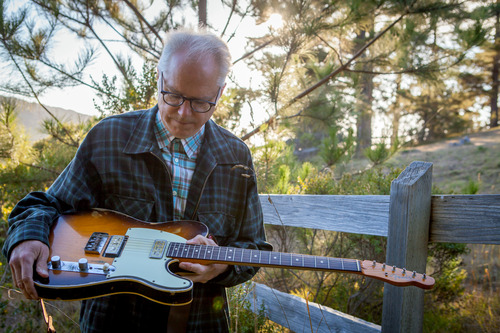
An Interview with Guitarist Bill Frisell
Bill Frisell is a tall, quiet man who seems to live his life in amazement. What was most surprising when we first met was how humbled he appeared to be in my presence. Frisell is perhaps the leading American jazz guitarist of his generation, having put out dozens of albums since the early 1980s featuring collaborations with everyone from John Zorn to Elvis Costello. And still, when we talked music, at the mention of a new name Bill’s response was always the same: to sit in thought for a moment, and then light up and say, “Wow.” Often it was just that: “Wow.“ A simple recognition, a marker of respect, and no need to explain further.
For this conversation, I met Bill in his temporary studio at the Vermont Studio Center. His guitar lay in the corner and sheets of white manuscript paper hung neatly on the walls. The room was spartan, monkish, and totally unlike the music he makes, which he describes as coming from the same place as the monsters and sci-fi vehicles he drew as a kid. With my friend Alex Lewis, I’ve been interviewing jazz musicians about how knowledge and value are created and communicated through their work for a project called Expandable Sound. And as I talked with Bill, I began to see further into his inspirations—dreams, images, memories, fantasies, reflections—held together like a mosaic. Bill would stop short suddenly, under a spell, lost in wonder. We’d sit quietly for a beat, and I’d secretly hope for him to pick up the guitar, knowing it was those moments that led Bill to music.
—Jake Nussbaum
I. IT WAS ALL HAPPENING SO FAST
THE BELIEVER: Maybe you can start with how you found the guitar.
BILL FRISELL: I was born in 1951, and I remember so clearly the evening that my father brought a television home for the first time. I was three or four. It was a big deal to get a television, and I watched cartoons and became addicted, and every day I’d watch the Mickey Mouse Club—this group of kids with their Mouseketeer ear hats on—and at the end of every show the leader, an older guy named Jimmy, would gather all the kids around and play guitar and they’d sing. And I just remember being so fascinated by the thing that he was playing. I mean, it had Mickey Mouse painted on the front of it, but it was just this beautiful, strange object. And it had this power to bring these people together. After whatever happened during that day, this guy comes in with this thing and they all just sort of chill out and get...
You have reached your article limit
Sign up for a digital subscription and continue reading all new issues, plus our entire archives, for just $1.50/month.
Already a subscriber? Sign in




